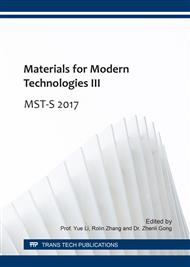[1]
K. Okubo, T. Sugeno, H. Tagaya, Chemical recycling of poly(p-phenylene sulfide) in high temperature fluids, Polym. Degrad. Stabil. 111 (2015) 109-113.
DOI: 10.1016/j.polymdegradstab.2014.10.027
Google Scholar
[2]
K. Shimizu, F.H. Blaikie, M. Kongsfelt, K.D.S. Sorensen, S.U. Pedersen, K. Daasbjerg, Electrochemical Procedure for Constructing Poly(phenylene sulfide) Brushes on Glassy Carbon and Stainless Steel, J. Polym. Sci. Pol. Chem. 54 (2016) 91-98.
DOI: 10.1002/pola.27893
Google Scholar
[3]
N.R. Kang, S.Y. Lee, D.W. Shin, D.S. Hwang, K.H. Lee, D.H. Cho, J.H. Kim, Y.M. Lee, Effect of end-group cross-linking on transport properties of sulfonated poly(phenylene sulfide nitrile)s for proton exchange membranes, J. Power Sources 307 (2016).
DOI: 10.1016/j.jpowsour.2016.01.051
Google Scholar
[4]
N. Zwettler, J.S. Engbaek, R. Lundsgaard, I. Paranowska, T.E. Nielsen, S. Clyens, J. Christiansen, M.O. Andersen, Chemical surface functionalization of bulk poly (p-phenylene sulfide) yields a stable sulfonic acid catalyst, React. Funct. Polym. 88 (2015).
DOI: 10.1016/j.reactfunctpolym.2015.02.006
Google Scholar
[5]
Y. Gao, Q. Fu, L. Niu, Z. Shi, Enhancement of the tensile strength in poly(p-phenylene sulfide) and multi-walled carbon nanotube nanocomposites by hot-stretching, J. Mater. Sci. 50 (2015) 3622-3630.
DOI: 10.1007/s10853-015-8923-2
Google Scholar
[6]
S. Nara, H.T. Oyama, Effects of partial miscibility on the structure and properties of novel high performance blends composed of poly(p-phenylene sulfide) and poly(phenylsulfone), Polym. J. 46 (2014) 568-575.
DOI: 10.1038/pj.2014.21
Google Scholar
[7]
A. Noll, K. Friedrich, T. Burkhart, U. Breuer, Effective multifunctionality of poly(p-phenylene sulfide) nanocomposites filled with different amounts of carbon nanotubes, graphite, and short carbon fibers, Polym Composite 34 (2013) 1405-1412.
DOI: 10.1002/pc.22427
Google Scholar
[8]
S.P. Ju, T.J. Haung, C.H. Liao, J.W. Chang, Investigation of thermal conductivity of graphite flake/poly (p-phenylene sulfide) composite by experimental measurement and non-equilibrium molecular dynamics simulation, Polymer 54 (2013) 4702-4709.
DOI: 10.1016/j.polymer.2013.06.013
Google Scholar
[9]
J.M. Gonzalez-Dominguez, P. Castell, S. Bespin-Gascon, A. Anson-Casaos, A.M. Diez-Pascual, M.A. Gomez-Fatou, A.M. Benito, W.K. Maser, M.T. Martinez, Covalent functionalization of MWCNTs with poly(p-phenylene sulphide) oligomers: a route to the efficient integration through a chemical approach, J. Mater. Chem. 22 (2012).
DOI: 10.1039/c2jm35272a
Google Scholar
[10]
D.R. Fahey, C.E. Ash, Mechanism of poly(para-phenylene sulfide) growth from para-dichlorobenzene and sodium sulfide, Macromolecules 24 (1991) 4242-4249.
DOI: 10.1021/ma00015a003
Google Scholar
[11]
R.W. Campbell, J. James T. Edmonds, U.S. Patent 4, 038, 259. (1977).
Google Scholar
[12]
J. James T. Edmonds, J. Harold Wayne HiIl, U.S. Patent 3, 354, 129. (1967).
Google Scholar
[13]
R.W. Lenz, C.E. Handlovits, H.A. Smith, Phenylene sulfide polymers. III. The synthesis of linear polyphenylene sulfide, Journal of Polymer Science 58 (1962) 351-367.
DOI: 10.1002/pol.1962.1205816620
Google Scholar
[14]
R.W. Lenz, C.E. Handlovits, Phenylene sulfide polymers. II. Structure of polymers obtained by the Macallum polymerization, Journal of Polymer Science 43 (1960) 167-181.
DOI: 10.1002/pol.1960.1204314113
Google Scholar
[15]
M. Wejchan-Judek, E. Rogal, The influence of a catalyst on the synthesis of poly (p-phenylene sulphide) from thiophenol and thionyl chloride, Polymer communications 25 (1984) 53-54.
DOI: 10.1016/0032-3861(81)90028-8
Google Scholar
[16]
M. Wejchan-Judek, E. Rogal, A. Zuk, Synthesis of poly-p-phenylene sulphide by oxidation of thiophenol with thionyl chloride in the presence of aluminium chloride, Polymer 22 (1981) 845-847.
DOI: 10.1016/0032-3861(81)90028-8
Google Scholar
[17]
A. Zuk, M. Wejchan-Judek, E. Rogal, Homopolycondensation of thiophenol, Polymer 19 (1978) 438-440.
DOI: 10.1016/0032-3861(78)90252-5
Google Scholar
[18]
C.W. Moberly, U.S. Patent 3, 878, 176. (1975).
Google Scholar
[19]
F. Aida, Y. Takatori, D. Kiyokawa, K. Nagamatsu, H. Nishide, K. Oyaizu, Poly(1, 4-phenylene sulfide) (pps) synthesis via oxidative polymerization of diphenyl disulfide: mechanistic insight into the selective formation of 1, 4-thiophenylene chain, Chem. Lett. 44 (2015).
DOI: 10.1246/cl.150146
Google Scholar
[20]
L. Chen, Sythesis of hyperbranched poly (phenylene sulfide) via a poly(sulfonium cation) precursor, School of Chemistry and Chemical Engineering, Southwest University, Chongqin, China, 2013, p.66.
Google Scholar
[21]
S.O. Yemul, O.S. Yemul, S. Ponrathnam, C. Rajan, A. Fradet, Synthesis of poly (thio‐1, 4‐phenylene) by oxidative coupling reaction of diphenyl disulfide with potassium persulfate in strongly acidic solutions, Macromol. Rapid. Comm. 19 (1998).
DOI: 10.1002/(sici)1521-3927(19981201)19:12<635::aid-marc635>3.0.co;2-6
Google Scholar
[22]
E. Tsuchida, E. Shouji, F. Suzuki, K. Yamamoto, Synthesis of Poly (phenylene sulfide) by O2 Oxidative Polymerization of Methyl Phenyl Sulfide, Macromolecules 27 (1994) 1057-1060.
DOI: 10.1021/ma00082a027
Google Scholar
[23]
K. Yamamoto, E. Tsuchida, H. Nishide, M. Jikei, K. Oyaizu, Oxovanadium-catalyzed oxidative polymerization of diphenyl disulfides with oxygen, Macromolecules 26 (1993) 3432-3437.
DOI: 10.1021/ma00065a029
Google Scholar
[24]
E. Tsuchida, E. Shouji, K. Yamamoto, Synthesis of high-molecular-weight poly (phenylene sulfide) by oxidative polymerization via poly (sulfonium cation) from methyl phenyl sulfoxide, Macromolecules 26 (1993) 7144-7148.
DOI: 10.1021/ma00078a005
Google Scholar
[25]
E. Tsuchida, K. Yamamoto, H. Nishide, S. Yoshida, M. Jikei, Polymerization of diphenyl disulfide by the SS bond cleavage with a Lewis acid: a novel preparation route to poly (p-phenylene sulfide), Macromolecules 23 (1990) 2101-2106.
DOI: 10.1021/ma00210a001
Google Scholar
[26]
E. Tsuchida, K. Yamamoto, M. Jikei, H. Nishide, Oxidative polymerization of diphenyl disulfides with quinones: formation of ultrapure poly (p-phenylene sulfide) s, Macromolecules 23 (1990) 930-934.
DOI: 10.1021/ma00206a004
Google Scholar
[27]
E. Tsuchida, K. Yamamoto, M. Jikei, H. Nishide, New synthesis of poly (phenylene sulfide) s through oxygen oxidative polymerization of diphenyl disulfide with vanadium oxide catalyst, Macromolecules 22 (1989) 4138-4140.
DOI: 10.1021/ma00200a062
Google Scholar
[28]
E. Tsuchida, K. Yamamoto, H. Nishide, S. Yoshida, Poly (p-phenylene sulfide)-yielding polymerization of diphenyl disulfide by SS bond cleavage with a Lewis acid, Macromolecules 20 (1987) 2030-(2031).
DOI: 10.1021/ma00174a060
Google Scholar
[29]
E. Tsuchida, H. Nishide, K. Yamamoto, S. Yoshida, Electrooxidative polymerization of thiophenol to yield poly (p-phenylene sulfide), Macromolecules 20 (1987) 2315-2316.
DOI: 10.1021/ma00175a046
Google Scholar


